Chicago Tribune reporter Ellen Gabler has published an article exposing the Consumer Safety Product Commission’s (CPSC) less than adequate job of investigating the role that crib bumper pads play in infant suffocation. The article reported that there have been 17 cases of infant deaths reported to CPSC that were not thoroughly investigated.
Although they had not investigated them, CPSC says other crib items such as blankets and pillows or even medical conditions could be to blame in these 17 infant deaths.
“If the baby was found with the face smushed up against the bumper pad, then I don’t understand the relevance of the pillow or the blanket,” said Dr. Rachel Moon, a pediatrician at Children’s National Medical Center and researcher for the American Academy of Pediatrics.
Bumper pads were originally created to cover the space between crib slats that were too far apart. The space between slats was reduced, but they are still being sold 40 years later and are causing an unnecessary hazard.
The Chicago Tribune also published an article in December 2010 on the hidden hazards of bumper pads. This article featured the stories of Preston and Aiden, two babies who lost their lives to bumper pads. The article also states that federal regulators have known about the hazards of bumper pads for years but has failed to warn parents and remove the item from stores. A study done by Washington University pediatrician Bradley Thach concluded that over two decades, at least 27 infant deaths have been attributed to bumper pads. Again, the Tribune article shows CPSC downplaying the role of bumper pads in infant deaths, claiming there were other contributing factors in each case.
KID recommends that babies be put to sleep on their backs in a bare crib without pillows or soft bedding present in their cribs. KID wrote a blog post on the December 2010 article found here.
Check out our other blog post today on Aiden’s grandmother’s mission to raise funds and awareness of this issue with a hike along the Appalachian Trail — starting April 1.


